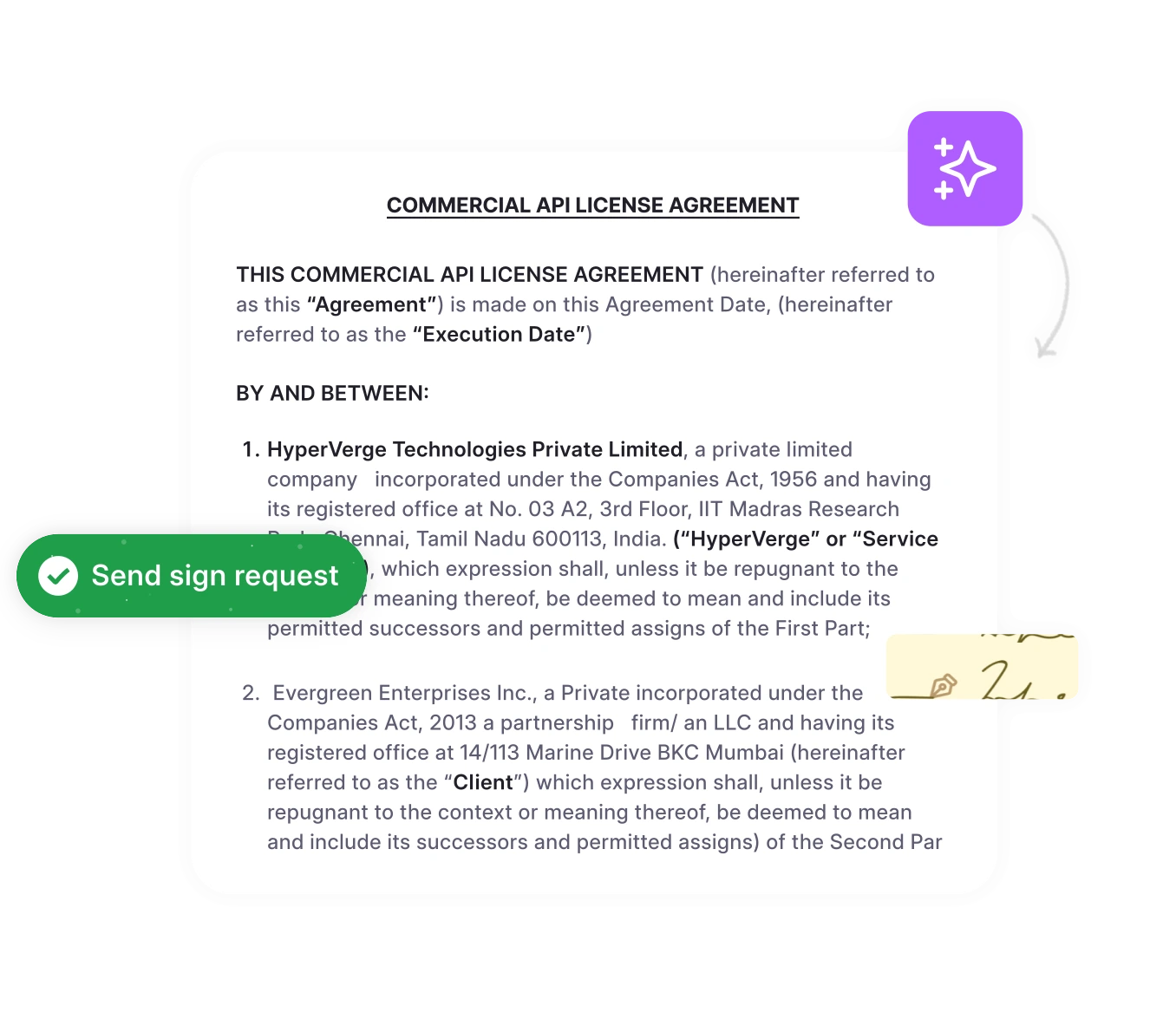Whether you’re negotiating a vendor agreement, onboarding new employees, or entering new markets, contract law forms the foundation of every business relationship.
From simple purchase orders agreement to complex partnership agreements, understanding contractual principles isn’t just for lawyers—it’s essential for anyone who wants to protect their business interests and operate with confidence.
Contracts aren’t just legal documents—they’re strategic tools that can make or break your success. A poorly understood agreement can lead to costly disputes, missed opportunities, and damaged relationships. Conversely, mastering contract fundamentals empowers you to negotiate better terms, avoid common pitfalls, and turn every agreement into a competitive advantage.
This comprehensive guide will help you understand what contract law is, its key elements, different types of contracts, and the role of CLM systems in contract law.
What is contract law?
Contract law is the body of legal principles that governs the formation, interpretation, and enforcement of agreements between parties. Rooted in both common law traditions and statutory law, it provides the framework that makes business relationships predictable, enforceable, and fair. At its core, it provides the framework that makes business relationships predictable, enforceable, and fair.
Contract law serves three fundamental purposes:
- Creates legal obligations that parties must fulfill
- Provides remedies when agreements are breached
- Establishes standards for what constitutes a valid agreement
According to the Legal Information Institute at Cornell Law School, most principles of common law contract formation are outlined in the Restatement of Law, Second Contracts published by the American Law Institute Contracts 2024 | H2O, which serves as the authoritative guide for courts nationwide.
Unlike other areas of law that primarily involve government regulation, contract law is largely based on the principle of freedom of contract—the idea that competent parties should be free to determine the terms of their relationships. This makes it particularly relevant for businesses, as it allows organizations to create customized arrangements that meet their specific operational needs.
The business impact of contract law
Modern businesses operate in a contract-driven environment. Consider these scenarios:
- A SaaS company’s terms of service (contractual agreement with users)
- Employment contracts that define worker relationships
- Vendor agreements that ensure supply chain reliability
- Partnership deals that drive business growth
Each represents a legal contract with enforceable obligations. Understanding how contract law works helps businesses minimize legal risks, optimize operational efficiency, and build stronger professional relationships.
After defining contract law, it is crucial to explore the key elements that determine whether an agreement qualifies as a valid contract.
What are the essential principles of contract law?
A legally enforceable contract must contain 5 essential elements. Missing even one can render a contract void or unenforceable, potentially leaving your business exposed to significant risk.
1. Offer: The foundation of the agreement
An offer is a specific proposal made by one party (the offeror) to another party (the offeree), indicating willingness to enter into a contract under stated terms.
Key characteristics of a valid contract offer:
- Must be definite (not vague or ambiguous)
- Must be communicated to the intended party
- Must demonstrate serious intent to create legal obligations
2. Acceptance: creating mutual agreement
Acceptance occurs when the offeree agrees to the exact terms of the offer without modification. This creates what contract law calls a “meeting of the minds.”
Requirements for valid acceptance:
- Must be unconditional and mirror the offer exactly
- Must be communicated to the offeror
- Must occur before the offer expires or is revoked
Methods of acceptance:
- Express acceptance: Verbal or written contract acceptance.
- Implied acceptance: Conduct that demonstrates agreement (e.g., making payment).
- Performance acceptance: Beginning to perform contractual duties.
Becomes a new offer. Note that an exception to the Mirror Image rule is found in the Uniform Commercial Code (“UCC”) for contracts between merchants for the sale of goods (the UCC does not apply to services rendered).
3. Consideration: The exchange of value
Consideration is what each party gives in return for something. This principle, known as bargain theory, requires that both parties exchange something of value, distinguishing contracts from gifts or one-sided promises or gifts.
Types of consideration:
- Monetary payment: Cash, financing, or monetary promises.
- Services: Professional work, consulting, or labor.
- Goods: Physical products or materials.
- Promises: Commitments to perform future actions,
- Forbearance: Agreeing not to do something you have the right to do.
The adequacy vs. sufficiency rule: Courts generally don’t evaluate whether consideration is adequate (fair market value) but only whether it’s sufficient (something of legal value was exchanged).
4. Capacity: legal ability to contract
Contractual capacity refers to a party’s legal ability to enter into binding agreements. Certain individuals and entities may lack the capacity to contract, making agreements voidable or void.
Parties who may lack capacity:
- Minors: Generally under 18 years old (varies by jurisdiction).
- Mentally incapacitated individuals: Those unable to understand the nature and consequences of the agreement.
- Intoxicated persons: Individuals under the influence of alcohol or drugs at the time of contracting.
- Corporate representatives: Individuals without proper authority to bind their organization.
Business Implications: Always verify that the person signing a contract has the authority to bind their organization. Request corporate resolutions or authorization letters for significant agreements.
5. Mutual Assent: Meeting of the minds
Mutual assent means both parties understand and agree to the essential terms of the contract. It’s important to note that while most contracts require this bilateral exchange, unilateral contracts exist where only one party makes a promise in exchange for the other party’s performance (such as reward offers). This goes beyond just offer and acceptance—it requires genuine understanding and agreement.
Factors that can prevent assent to mutual obligations:
- Misrepresentation: False statements about material facts
- Mistake: Errors in understanding key contract terms
- Duress: Threats or coercion that pressure an agreement
- Undue influence: Abuse of a position of trust or authority
Best practice: Use clear, plain language in contracts and ensure all parties have adequate time to review and understand terms before signing.
Turn complex contracts into actionable insights
HyperStart reviews your agreements to highlight risky clauses and legal gaps—helping you act with confidence.
Book a DemoThe Restatement (Second) of the Law of Contracts outlines core principles that guide contract formation and enforcement in the US:
Offer and Acceptance: Contracts require a clear offer and a definite acceptance to create mutual agreement.
Consideration: Each party must exchange something of value for the contract to be valid.
Capacity: Parties must have the legal ability to enter into a contract.
Legality: The contract’s purpose must comply with the law.
Mutual Assent: Both parties must intend to be bound, free from fraud or duress.
Performance and Breach: Defines when obligations are met or breached, and available remedies.
Good Faith: Parties must act honestly and fairly during contract performance.
These principles help ensure contracts are clear, enforceable, and reduce the risk of disputes.
With a clear understanding of the essential elements that make a contract valid, it’s equally important to explore the various types of contracts commonly used in business to meet different needs and situations.
What are the different types of contracts in business?
Understanding different contract classifications helps businesses choose the appropriate structure for their specific needs and understand their legal implications.
| Contract Type | Description | Business Use Cases | Legal Implications |
| Express Contracts | Terms explicitly stated in writing or orally | Service agreements, employment contracts, and purchase orders | Clear evidence of terms, easier to enforce |
| Implied Contracts | Formed through conduct and circumstances of implied promises | Ongoing vendor relationships, professional services | Terms inferred from behavior, harder to prove specific terms |
| Unilateral Contracts | One party makes a promise in exchange for performance | Reward offers, commission agreements | Only the offeror is bound until performance occurs |
| Bilateral Contracts | Both parties exchange mutual promises | simple contracts and business dealings | Both parties are bound from the contract formation |
Also read Unilateral vs Bilateral Contracts: A Guide
Classification by performance
Executory contracts: Contract obligations remain to be performed by one or both parties.
- Example: A signed software development contract where work hasn’t begun.
- Business Impact: Both parties remain legally obligated to perform.
Executed contracts: All obligations have been fully performed.
- Example: A completed equipment purchase with full payment and delivery.
- Business Impact: Contract obligations are satisfied, though warranty terms may survive.
Classification by enforceability
- Valid contracts: Meet all legal requirements and are fully enforceable.
- Void contracts: Not legally binding contracts due to fundamental defects (e.g., illegal purpose).
- Voidable contracts: Valid until one party chooses to void (e.g., contracts with minors).
- Unenforceable contracts: Valid but cannot be enforced due to legal technicalities.
Not all business agreements are legally enforceable contracts. Understanding when enforcement fails is crucial to managing risks effectively.
When can’t contracts be enforced?
Not all agreements that appear to be contracts are legally enforceable. Understanding when contracts become unenforceable protects your business from entering into invalid agreements and helps you identify potential issues in existing contracts.
1. Void contracts
Void contracts are considered invalid from the moment they’re created and have no legal effect. Common reasons include:
- Illegal Subject Matter: Contracts that require illegal activities or violate public policy.
- Lack of Legal Capacity: Agreements with parties who cannot legally contract.
- Impossibility from the Start: Contracts requiring performance that was impossible when the agreement was made.
In the 130th of the Criminal Code of Illinois it is provided that ‘whoever contracts to have or give to himself or another the option to sell or buy, at a future time, any grain, or other commodity, stock of any railroad or other company, or gold, or forestalls the market by spreading false rumors to influence the price of commodities therein, or corners the market, or attempts to do so about any of such commodities, shall be fined not less than $10 nor more than $1,000, or confined in the county jail not exceeding one year, or both.
All contracts made in violation of this section shall be considered gambling contracts and shall be void.
2. Voidable contracts
Voidable contracts are initially valid but can be canceled by one party due to specific circumstances.
- Misrepresentation or Fraud: When one party provides false information that influences the other’s decision. Business Impact: The deceived party can choose to void the contract or enforce it.
- Duress or Undue Influence: Agreements made under pressure or coercion. Example: Contracts signed under threats or by taking advantage of someone in distress.
- Mistake: Significant errors in understanding fundamental contract terms. Mutual Mistake: Both parties misunderstood key facts. Unilateral Mistake: One party’s error (less commonly grounds for voiding).
- Lack of Capacity: Contracts with minors, intoxicated persons, or those mentally. Note: These parties can choose to void the contract or affirm it when capacity is restored.
3. Unenforceable contracts
Unenforceable contracts meet basic contract requirements but cannot be enforced due to legal technicalities.
Statute of Frauds Violations: Certain contracts must be written to be enforceable
- Real estate transactions
- Contracts that cannot be performed within one year
- Sale of goods over $500 (under UCC)
- Guarantees of another’s debt
Statute of Limitations: Claims filed after the legal deadline for bringing contract disputes.
Unconscionable Terms: Contracts with grossly unfair terms or created through unfair bargaining
Ensure every agreement aligns with contract law standards
From indemnities to termination clauses, HyperStart gives your legal team AI-powered visibility to reduce exposure.
Book a DemoOnce we understand the situations where contracts cannot be enforced, it’s important to explore what constitutes a breach of contract when the terms of a valid agreement are not fulfilled.
What is considered a breach of contract?
A breach of contract occurs when one party fails to perform any duty or obligation specified in the contract without legal justification. When contracts are breached, understanding available remedies helps businesses protect their interests and recover appropriate compensation. The Legal Information Institute at Cornell defines expectation damages as compensation intended to put the non-breaching party in as good a position as if the breaching party had fully performed their contractual duties.
1. Material Breach (Fundamental Breach)
A significant failure that defeats the essential purpose of the contract and substantially frustrates the other party’s expectations.
- Example: A web development company delivers a completely non-functional website instead of the agreed-upon e-commerce platform.
- Consequence: The non-breaching party can typically terminate the contract and seek monetary damages.
- Business Impact: May excuse the other party from performing their obligations.
2. Minor Breach (Partial Breach)
A failure to perform that doesn’t destroy the contract’s essential purpose but still violates specific terms.
- Example: A supplier delivers goods two days late when a timely delivery was specified.
- Consequence: The non-breaching party must still perform, but can seek damages for the delay.
- Business Impact: Contract remains in effect, but compensation may be owed.
3. Anticipatory Breach
When one party indicates they will not perform their contractual obligations before performance is due.
- Example: A contractor states they cannot complete a project due to financial difficulties before the work deadline.
- Consequence: The other party can immediately treat the contract as breached without waiting for the performance date.
- Business Impact: Allows early termination and pursuit of alternative arrangements.
This case is a foundational principle for damages in breach of contract. It established that damages should only cover losses that are a natural consequence of the breach or were reasonably foreseeable by both parties at the time the contract was formed.
Understanding what constitutes a breach of contract highlights the importance of efficient contract management, where CLM systems play a key role in helping organizations create, monitor, and enforce agreements effectively.
What is the role of CLM systems in contract law?
Modern Contract Lifecycle Management (CLM) systems have transformed how businesses handle legal obligations and contractual relationships.
These platforms don’t just store documents—they actively support contract law compliance, risk management, and operational efficiency throughout the entire contract lifecycle. These platforms help identify potential issues with unequal bargaining power by flagging deviant terms and ensuring contracts comply with both common law principles and relevant statutory law requirements.
1. Enhanced contract formation and review
CLM platforms streamline the creation of legally sound contracts by providing standardized templates that incorporate essential contract law elements. Advanced systems use AI to identify missing clauses, flag potential legal risks, and ensure all six essential elements (offer, acceptance, consideration, capacity, legality, and mutual assent) are properly addressed.
For example, HyperStart’s AI-powered contract analysis can identify when a contract lacks proper consideration or contains deviant terms, helping businesses avoid the risks.
2. Automated compliance and risk management
One of the most significant challenges in contract law is maintaining ongoing compliance with contractual obligations. CLM systems address this by automatically tracking key dates, performance metrics, and regulatory requirements.
3. Breach prevention and early detection
Modern CLM platforms excel at identifying potential contract issues before they escalate into formal breaches. By monitoring contract performance and flagging deviations from agreed terms, these systems enable proactive contract management.
4. Streamlined dispute resolution
Audit trails and comprehensive documentation are useful in the event of a dispute, ensuring quick access to all relevant contract history for efficient legal review.
HyperStart’s platform, for instance, provides detailed contract analytics that can demonstrate compliance patterns and performance history, strengthening your position in any renegotiation resolution process.
5. Integration with legal operations
Modern CLM platforms integrate seamlessly with broader legal operations, connecting contract management with legal research, case management, and regulatory compliance systems. This integration ensures that contract law principles are consistently applied across all business relationships.
Mastering contract law for business success
Understanding contract law fundamentals isn’t just about legal compliance—it’s about creating competitive advantage through better business relationships, reduced risks, and increased operational efficiency. The most successful organizations combine solid legal foundations with modern technology solutions to transform their contractual relationships from legal necessities into strategic assets.
Today’s leading businesses are achieving remarkable results by implementing intelligent contract management platforms. Organizations like Qapita opted for HyperStar and got streamlined approval workflows with easy-to-configure no-code options. This reduced their turnaround time by 5X.
Frequently asked questions
Monetary Damages:
Equitable Remedies:
Alternative Theories:
The appropriate remedy depends on the breach circumstances and type of harm suffered.












